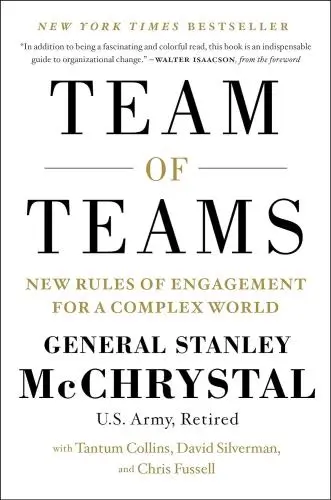Team of Teams
New Rules of Engagement for a Complex World
What's it about?
In Team of Teams, General Stanley McChrystal uses his experience reorganizing the U.S Special Forces to impart battlefield-tested strategies that apply to today's dynamic business environment. He spotlights the need for a shift from rigid hierarchies to a fluid 'team of teams' system, transforming silos into communication channels and advocating for accelerated decision-making. The book explores nuanced concepts like shared consciousness and radical decentralization, offering fresh perspectives on leadership and collaboration. Team of Teams, written in an accessible manner, is not just a book, but a guide for navigating the unpredictable digital age successfully.
About the Author
General Stanley McChrystal, a titan in modern military leadership, masterfully bridges battlefield experiences with transformative leadership lessons in works like "Team of Teams." His writing, infused with the clarity and precision honed over decades in the military, offers unique insights into adapting and thriving amidst chaos. McChrystal's books are essential for those seeking to lead in an ever-evolving world, blending gritty realities with innovative strategies.
10 Key Ideas of Team of Teams
Foster a Shared Consciousness for Enhanced Team Unity
Creating a shared consciousness involves ensuring that every team member understands the mission, goals, and values of the organization.
This is achieved through transparent communication and by making strategic information accessible to all.
It encourages a sense of ownership and responsibility across the team, as members are more likely to contribute effectively when they understand how their work fits into the larger picture.
This approach breaks down silos, promotes cross-functional collaboration, and enables faster decision-making, as team members can act autonomously with a clear understanding of the collective objective.
Learn DeeperCommunicate Openly and Regularly: Make it a habit to share updates, challenges, and successes with your team. Use regular meetings, emails, or project management tools to keep everyone in the loop.
Encourage Questions and Feedback: Create an environment where team members feel comfortable asking questions and providing feedback. This can be through regular check-ins, suggestion boxes, or open-door policies.
Share the Big Picture: Regularly remind your team of the organization's goals, mission, and values. Use visual aids like flowcharts or diagrams to illustrate how each team member's work contributes to these objectives.
Promote Cross-Functional Collaboration: Encourage team members from different departments to work together on projects or initiatives. This can be facilitated through team-building activities, cross-departmental meetings, or shared workspaces.
Empower Decision-Making: Trust your team members by delegating authority and empowering them to make decisions within their scope of work. Provide guidance and support, but allow them to take ownership of their tasks.
- Example
A software development company implements a weekly 'all-hands' meeting where each department shares updates and discusses how their work aligns with the company's objectives. This fosters a sense of unity and clarity among team members.
- Example
A marketing team uses a shared online dashboard where all team members can post updates, ask questions, and offer feedback on ongoing projects. This ensures everyone is on the same page and can see how their contributions fit into the larger campaign.
Empower Decision Making at All Levels for Agile Response
Empowering decision-making at all levels means delegating authority so that decisions can be made closer to the action.
This tactic reduces bottlenecks in the decision-making process, allowing the team to respond more quickly to changes and opportunities.
It requires trust in the team's capabilities and a shift away from top-down control.
By empowering individuals, teams become more adaptable and can leverage frontline insights, leading to more effective and timely responses to challenges.
Learn DeeperTrust Your Team: Start by building a culture of trust within your team. Trust that they have the skills and judgment to make decisions. This can be done through regular training, open communication, and by giving them smaller decisions to make as practice.
Delegate Decision-Making Authority: Identify areas where decisions can be safely made by those closer to the action. Clearly communicate these areas to your team, along with any necessary guidelines or constraints.
Provide Access to Information: Ensure that all team members have access to the information they need to make informed decisions. This might involve improving your team's communication channels or data-sharing practices.
Encourage Accountability: Encourage team members to take ownership of their decisions. This involves recognizing and celebrating good decisions, as well as viewing mistakes as learning opportunities rather than failures.
Review and Adjust: Regularly review the outcomes of decentralized decision-making. Discuss what's working and what isn't in team meetings, and adjust your approach as needed to improve effectiveness.
- Example
In a software development team, instead of having every code change approved by a senior developer, empower all developers to approve changes that meet certain criteria. This speeds up the development process and leverages the collective expertise of the team.
- Example
In a retail environment, empower store managers to make inventory decisions based on their specific store's sales data and customer feedback, rather than adhering strictly to corporate mandates. This allows for more responsive and localized inventory management.
Implement Cross-Functional Teams for Enhanced Problem Solving
Cross-functional teams bring together diverse skill sets and perspectives, fostering innovation and comprehensive problem-solving.
By integrating members from different departments or specialties, these teams can address complex issues more holistically.
This approach encourages learning and knowledge sharing across traditional boundaries, breaking down silos and enhancing the team's overall capability.
It also allows for more creative solutions, as varied viewpoints can uncover unique approaches to challenges.
Learn DeeperIdentify the Challenge: Start by clearly defining the problem you're trying to solve. This will help in selecting the right mix of skills and perspectives needed on your cross-functional team.
Select Diverse Team Members: Choose individuals from different departments or areas of expertise who can contribute unique insights and solutions. Look for a mix of creative thinkers, technical experts, and strong communicators.
Foster Open Communication: Encourage team members to share their ideas and perspectives openly, without fear of judgment. This can be facilitated through regular meetings, brainstorming sessions, and using collaborative tools.
Set Clear Goals and Roles: Ensure every team member understands the team's objectives and their specific role in achieving them. This clarity will help streamline efforts and reduce confusion.
Celebrate Diverse Perspectives: Actively acknowledge and value the different viewpoints within the team. This not only boosts morale but also encourages further sharing of innovative ideas.
Review and Adapt: Regularly assess the team's progress and dynamics. Be open to adjusting strategies, roles, or even team composition to better address the challenge at hand.
- Example
A software development company facing a decline in user engagement forms a cross-functional team consisting of developers, UI/UX designers, customer support representatives, and marketing professionals. Together, they analyze user feedback, identify pain points, and develop a more intuitive and engaging user interface.
- Example
A healthcare provider looking to improve patient satisfaction assembles a team of doctors, nurses, administrative staff, and patients' family members. This team works together to identify shortcomings in the current patient care process and implements a new approach that focuses on personalized care, resulting in higher satisfaction rates.
Cultivate a Culture of Continuous Learning and Adaptation
A culture of continuous learning encourages team members to constantly seek improvement, both personally and collectively.
This involves regular training, feedback loops, and an openness to change.
By valuing adaptation and resilience, teams can better navigate the uncertainties of their environment.
This culture supports innovation, as team members feel safe to experiment and learn from failures, leading to breakthroughs and advancements.
Learn DeeperCreate a Learning Plan: Identify areas where you and your team can improve. Set specific, measurable goals for learning new skills or enhancing existing ones. Allocate time each week for this purpose, whether it's through online courses, workshops, or reading.
Foster Open Communication: Encourage team members to share their successes and failures openly. Hold regular meetings where everyone can discuss what they've learned recently and how it can be applied to your collective work. This not only promotes learning but also builds trust.
Implement Feedback Loops: Make feedback a regular part of your team's workflow. After completing a project or task, conduct a review session to discuss what went well and what could be improved. Use this feedback to make adjustments and learn as a group.
Encourage Experimentation: Create a safe space for team members to try new approaches without fear of failure. Recognize and celebrate these efforts, regardless of the outcome, as each attempt is a learning opportunity.
Leverage Cross-Training: Encourage team members to learn about different aspects of your work or project. This not only enhances individual skill sets but also improves team cohesion and flexibility.
- Example
A software development team adopts agile methodologies, holding daily stand-up meetings to discuss progress and challenges. They dedicate Fridays to learning, where team members can explore new programming languages or work on personal projects that contribute to their professional growth.
- Example
A marketing team conducts monthly 'retrospectives' to evaluate their campaigns. They discuss what strategies worked, what didn't, and why. This practice helps them adapt quickly to market changes and innovate more effectively in their future projects.
Leverage Technology for Enhanced Communication and Coordination
Utilizing advanced communication and coordination tools can significantly enhance team efficiency and effectiveness.
Technology facilitates real-time information sharing and collaboration, regardless of geographical distances.
This ensures that all team members have access to the latest updates and resources, enabling synchronized efforts.
Additionally, technology can automate routine tasks, freeing up time for strategic thinking and problem-solving.
Learn DeeperEvaluate Your Current Tools: Take a moment to assess the communication and coordination tools your team currently uses. Are they meeting your needs? If not, it's time to explore other options that could streamline your processes.
Implement Regular Tech Check-ins: Schedule regular meetings to discuss and troubleshoot any issues with the technology you're using. This keeps everyone on the same page and ensures that your tools are as effective as possible.
Train Your Team: Make sure everyone is up to speed on how to use the new technologies effectively. Consider hosting training sessions or creating simple guides to help team members feel more comfortable and proficient.
Leverage Automation: Identify repetitive tasks that can be automated, such as scheduling or data entry. Implementing automation tools can save time and reduce errors, allowing your team to focus on more strategic activities.
- Example
A marketing team uses a project management tool like Trello or Asana to coordinate their campaigns. They set up boards for each project, assign tasks with deadlines, and use the comment feature to update each other on progress. This keeps everyone aligned and informed, regardless of their location.
- Example
A software development team adopts Slack for real-time communication and integrates it with GitHub for code sharing and review. This setup allows them to quickly discuss changes, address issues, and push updates, fostering a collaborative environment even when working remotely.
Deeper knowledge. Personal growth. Unlocked.
Unlock this book's key ideas and 15M+ more. Learn with quick, impactful summaries.
Read Full SummarySign up and read for free!
Team of Teams Summary: Common Questions
Experience Personalized Book Summaries, Today!
Discover a new way to gain knowledge, and save time.
Sign up for our 7-day trial now.
No Credit Card Needed

Similar Books

Emotional Intelligence at Work
Dalip Singh
Seeing the Big Picture
Kevin Cope
Leadership Is Concept Heavy
Dr. Enoch Antwi
Great by Choice
Jim Collins
The Leader′s Guide to Coaching in Schools
John Campbell
Preparing School Leaders for the 21st Century
Stephan Gerhard Huber
The E-Myth Manager
Michael E. Gerber
Leadership Is Language
L. David Marquet
Start-up Nation
Dan Senor
The Founder's Dilemmas
Noam WassermanTrending Summaries

Peak
Anders Ericsson
Never Split the Difference
Chris Voss
Smart Brevity
Jim VandeHei
The Psychology of Money
Morgan Housel
The First 90 Days
Michael D. Watkins
Atomic Habits
James Clear
Thinking, Fast and Slow
Daniel Kahneman
The Body Keeps the Score
Bessel van der Kolk M.D.
The Power of Regret
Daniel H. Pink
The Compound Effect
Darren HardyNew Books

TOP KNIFE: The Art & Craft of Trauma Surgery
Asher Hirshberg,
English Spirituality
Gordon Mursell
The ^AOxford Handbook of Job Loss and Job Search
Ute-Christine Klehe PhD
Job Interviews For Dummies®
Joyce Lain Kennedy
Job Interviews In A Week
Alison Straw
Handbook of Career Development
Gideon Arulmani
The Art of Spending Money
Morgan Housel
$100M Offers
Alex Hormozi
A Candle for Kiri
Edna Mae Holm

